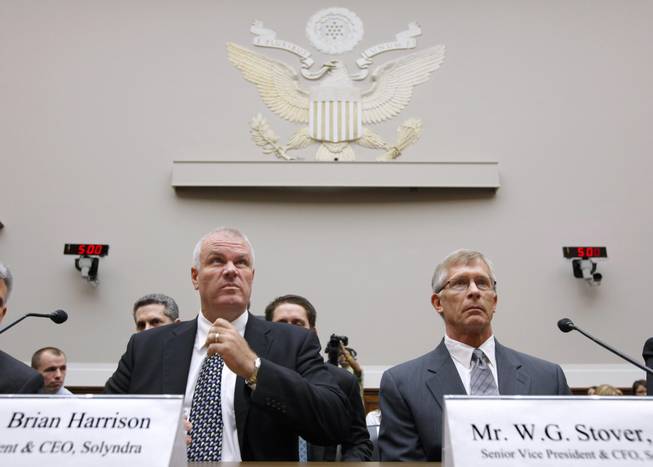
AP Photo/J. Scott Applewhite
Solyndra CEO Brian Harrison, left, and Chief Financial Officer Bill Stover, right, are seen in on Capitol Hill in Washington, Friday, Sept. 23 2011, prior to a House Oversight and Investigations subcommittee hearing.
Monday, Sept. 26, 2011 | 2:27 p.m.
You won’t find their photovoltaic cells anywhere near Nevada solar projects, but the flap surrounding failed solar panel maker Solyndra could cause the federal government to pull the plug on two Nevada solar power plants by the end of the week.
The 110-megawatt Crescent Dunes solar power storage plant in Tonopah and the 20-megawatt Fotowatio solar power plant in northeast Las Vegas had both received conditional commitments from the government’s renewable energy loan guarantee program earlier this year. But according to the Department of Energy’s website, those loans haven’t been finalized and if they aren’t finalized by Sept. 30, the money, about $800 million total, just goes away with the approximately 900 jobs they were going to create.
The Nevada projects are two of 11 renewable energy projects nationwide coming under extra scrutiny as they await final approval of federal loan guarantees, because of a growing scandal.
California-based Solyndra, a solar panel manufacturer and the first recipient of a “section 1705” renewable energy loan guarantee of $535 million in 2009, declared bankruptcy this month, shut down operations and fired all 1,100 of its employees.
The failure of the company the Obama administration once made a poster child of the new energy era has cast a dark cloud over the federal program that led to its existence. Solyndra executives are under an official congressional investigation by a House panel over whether they duped the government, and Republican lawmakers have speculated aloud that the Obama administration may have rushed the due diligence process not only with Solyndra, but with other loan guarantee recipients as well, overlooking problems that could end up costing billions.
Solyndra is less likely to reflect problems in the federal loan program as it is emblematic of the uncertainty surrounding new economic ventures. When the idea of crafting cylindrical, non-silicon photovoltaic cells was conceived, the cost of producing solar panels was still sky-high; but by the time production was up and running, solar panels had become so cheap that the Solyndra product just couldn’t sell. Investors -- including the government -- tried to buy the company more time to get cost-competitive, but in the end, couldn’t save it.
Still, the scandal has placed loan guarantee programs under the microscope, as Republicans strive to shave $100 million from the program as part of their proposed offsets for disaster funding. That’s just about the amount the government lost on the Solyndra bankruptcy declaration.
That $100 million is a pittance compared to what’s been spent: The government has approved $38.6 billion in renewable energy loan guarantees thus far, and the unfinalized projects represent another $7.1 billion, according to the Department of Energy’s loan programs office. It’s also likely less than the federal government will save by the time the project comes to a close: the government isn’t going to have to pay out anything on its single biggest conditional guarantee, a partial guarantee of $1.93 billion it made to the First Solar’s Topaz solar plant project in California. To finalize a loan guarantee, a project must have broken ground by Sept. 30 -- they won’t.
But that doesn’t appear to be a problem with Nevada’s pending projects.
“We broke ground earlier in September, so there’s a fair amount of work going on out there now,” Solar Reserve CEO Kevin Smith said in a phone interview Monday morning. Solar Reserve is the company behind the Crescent Dunes project in Tonopah.
He stressed that the company hadn’t paced their construction schedule just to make the government’s deadline. “There’s a real winter in Tonopah, and we need to have the tower complete by winter,” he said. “It was really a scheduling requirement for the project, regardless of the Sept. 30 deadline.”
While Smith wouldn’t comment on the status of his company’s loan guarantee application, he said there would be an announcement on that in the next couple of days.
A spokesman for SunEdison, which acquired the Fotowatio Renewable Venture project from the Spain-based company earlier this year, did not immediately return a request for comment.

Join the Discussion:
Check this out for a full explanation of our conversion to the LiveFyre commenting system and instructions on how to sign up for an account.
Full comments policy